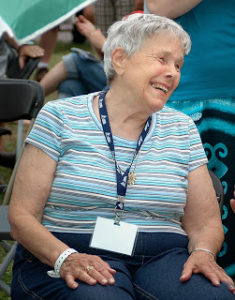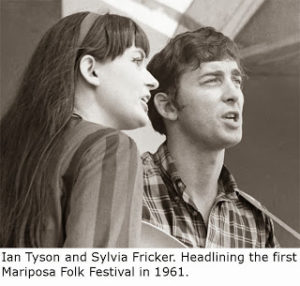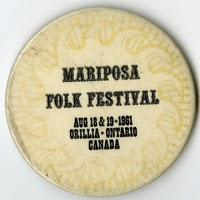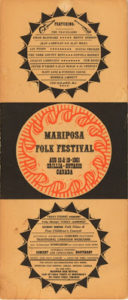The Person Whose Grand Idea Was Mariposa Folk Festival
Posted on Behind every grand idea there’s usually one extraordinary innovator, and this was the case with Mariposa Folk Festival in 1961. Ruth Jones-McVeigh was that spark and visionary driver. Due to her passion, today we can look back on a rich body of folk music history; recall festival memories that are etched into our collective conscience; regale with stories of pivotal performances and moments; and take stock of the generations of musicians that earned audience recognition, some with career-launching appearances, at Mariposa Folk Festival.
Behind every grand idea there’s usually one extraordinary innovator, and this was the case with Mariposa Folk Festival in 1961. Ruth Jones-McVeigh was that spark and visionary driver. Due to her passion, today we can look back on a rich body of folk music history; recall festival memories that are etched into our collective conscience; regale with stories of pivotal performances and moments; and take stock of the generations of musicians that earned audience recognition, some with career-launching appearances, at Mariposa Folk Festival.
If it wasn’t for Ruth, there would never have been a Mariposa Folk Festival.
Ruth Jones-McVeigh started life in Halifax, Nova Scotia, on December 20th, 1926. An only child until the age of 13, she had a bit of an adjustment when her brother came along, but they became very good friends over the years. Despite tough times coming through the Great Depression, her mother somehow found the money for Ruth to take piano, ballet, figure skating, riding and singing lessons. Sadly, when Ruth was 15, the world fell apart for her and her family. Ruth’s father, who had been away periodically during the war, left them for good. A wrenching emotional struggle between her parents ensued, culminating in divorce.
Skip ahead a few years, and Ruth is the 22 year-old bride of Dr. Crawford (Casey) Jones, a medical doctor in the Canadian Navy who was 7 years her senior. They had four children together – two boys and two girls – and a house on Lake Couchiching, in Orillia. The house was pretty run-down when they purchased it so, along with being a mom, Ruth became a renovator, decorator and gardener. Once, she decided she wanted a patio off of the kitchen, so she built one. She dug out an old oil tank that had been buried in the ground for ages, levelled everything off, then mixed and poured the concrete.
 Casey served as Superintendent of the Ontario Hospital School and, after becoming a psychiatrist he maintained a private practice in the family’s house. It was around that time that Ruth caught the folk music bug. She had been taking trips to Toronto once a month to treat herself and to get her hair done when she started visiting the Village Corner, one of Toronto’s early folk clubs. Folk music became an addiction, and she became friends with lots of people on the folk music scene including Don Cullen who operated the Bohemian Embassy folk club. (Don is a good friend of Mariposa Folk Festival to this day. He gave permission to use the iconic Bohemian Embassy name for one of the festival stages).
Casey served as Superintendent of the Ontario Hospital School and, after becoming a psychiatrist he maintained a private practice in the family’s house. It was around that time that Ruth caught the folk music bug. She had been taking trips to Toronto once a month to treat herself and to get her hair done when she started visiting the Village Corner, one of Toronto’s early folk clubs. Folk music became an addiction, and she became friends with lots of people on the folk music scene including Don Cullen who operated the Bohemian Embassy folk club. (Don is a good friend of Mariposa Folk Festival to this day. He gave permission to use the iconic Bohemian Embassy name for one of the festival stages).
It was about this time that John Fisher, a motivational speaker engaged by the federal government, was travelling across Canada with the message that “Every community should have a ‘hook’ to hang tourism on”. Ruth heard him speak, and later, while she was confined to bed with the flu, the idea struck her. She decided to liven up Orillia with a folk festival. Little did she know at the time, but her idea would do a lot more than give her town a needed boost – it went on to become a folk festival of national and international renown.
 Another important dimension of Ruth’s story is that her grand idea came to her during a period of profound personal sadness. She saw Orillia as stultifying in many ways. On top of that, Ruth was unhappy in her marriage, with Casey very focused on his work and Ruth feeling that she had no partner in life. Ruth needed a diversion, and the festival was a good one. Also around that time, she met someone else, an Afro-Canadian singer-guitarist named Doug – and the two fell in love. For a while, Ruth lived with one foot in each camp, trying to keep up appearances for Casey, a brilliant and generous man who loved her very much in his own way. He was also a wonderful father, and the kids adored him. Soon, however, Ruth was feeling torn apart.
Another important dimension of Ruth’s story is that her grand idea came to her during a period of profound personal sadness. She saw Orillia as stultifying in many ways. On top of that, Ruth was unhappy in her marriage, with Casey very focused on his work and Ruth feeling that she had no partner in life. Ruth needed a diversion, and the festival was a good one. Also around that time, she met someone else, an Afro-Canadian singer-guitarist named Doug – and the two fell in love. For a while, Ruth lived with one foot in each camp, trying to keep up appearances for Casey, a brilliant and generous man who loved her very much in his own way. He was also a wonderful father, and the kids adored him. Soon, however, Ruth was feeling torn apart.
Ruth never worked at anything before or since, as hard as she worked on that first Mariposa Folk Festival. Her diary from those days, which is now housed in the Mariposa Folk Festival archive at the Clara ThomasArchives and Special Collections at York University, attests to it.
Needless to say, that first Mariposa Folk Festival was a big success, and it served as a harbinger of great things to come. Ruth is always careful to point out that the first Mariposa Folk Festival could not have happened if Casey had not donated the start-up funds; if the whole family had not pitched in, stuffing envelopes while singing folk songs; if her brother, David Major, had not put her in touch with Ed Cowan, the first festival producer; and if her grandfather, Tom Freeman, then in his 80s, had not taken his very first flight to visit from Nova Scotia, to look after the four kids while Ruth buzzed around doing radio and television interviews to promote the inaugural festival.
Friday, August 18, 1961, the first day of the very first Mariposa Folk Festival, saw two thousand enthusiastic and generally well-behaved attendees set up their lawn chairs in front of a medieval-themed stage at the Orillia Community Centre (Lion’s Oval). Double that number showed up on Saturday night. The impressive line-up included O.J. Abbott, Omar Blondahl, Jean Carignan, Alan Mills, Jacques Labrecque, The Travellers, Al Cherney, Bonnie Dobson, the Canadian folklorist Edith Fowke, Merrick Jarrett, Alan McRae and Peter Wyborn, Finvola Redden, Ted Schafer, Mary Jane and Winston Young, the York County Boys and, of course, Ian Tyson and Sylvia Fricker. Ian Tyson also designed the original Lion’s Face Sun Logo of Mariposa Folk Festival.
 After that first festival, Ruth moved to Toronto where she worked at the Royal Ontario Museum as an assistant to the archivist, cataloguing paintings in the Sigmund Samuel Gallery of Canada – a job she loved. She also worked at Ronalds-Reynolds advertising agency – another dream job. Doug got a job in New York City as co-accompanist for Harry Belafonte, with John Sebastian, founder of The Lovin’ Spoonful. Ruth took a job (working illegally) as assistant to the director of a hospital in New York. One day, when Doug was returning to Toronto for a gig, he was stopped at the border. The authorities found out that he had entered the U.S. illegally, and now he couldn’t get back to New York. Meanwhile, Casey had developed leukemia, ultimately dying of the illness.
After that first festival, Ruth moved to Toronto where she worked at the Royal Ontario Museum as an assistant to the archivist, cataloguing paintings in the Sigmund Samuel Gallery of Canada – a job she loved. She also worked at Ronalds-Reynolds advertising agency – another dream job. Doug got a job in New York City as co-accompanist for Harry Belafonte, with John Sebastian, founder of The Lovin’ Spoonful. Ruth took a job (working illegally) as assistant to the director of a hospital in New York. One day, when Doug was returning to Toronto for a gig, he was stopped at the border. The authorities found out that he had entered the U.S. illegally, and now he couldn’t get back to New York. Meanwhile, Casey had developed leukemia, ultimately dying of the illness.
Soon after he was barred from the U.S., Doug left Ruth. It was a profoundly traumatic time, but Ruth picked herself up, packed the VW with everything she owned, and drove to the west coast. Casey sent their two daughters out to live with her, and he also helped her with the down payment on a house. Ruth went to work in the public relations office of Vancouver General Hospital.
Ruth then met Gerry, a professional forester 13 years younger, and a new chapter opened in her life. They had a mutual love of hiking and the woods and reading and music. After living together for a year, they married. Although Gerry wanted kids, Ruth was unable to conceive, so they adopted a baby girl. By the time their daughter joined the family, Ruth was pregnant. Just short of 45, she gave birth to her son Thom, 18 years after giving birth to her last child. The four McVeighs moved to Vancouver Island.
Following a series of ‘events’ including changes of jobs when Gerry was fired, Ruth wrote a book about living with swans in the wilderness titled Fogswamp, published by Hancock House, and went on a promotional tour across Canada. After the tour, they moved to Guyana, where they spent two wonderful years – mostly happy and always interesting. After Guyana, they returned to Canada, settling down in Ladysmith on Vancouver Island, where Ruth wrote her second book, Close Harmony – the story of a seniors’ musical group based in Penticton, B.C. Gerry couldn’t find work, so the two of them agreed that wherever one of them found a job, the other would follow with the kids. Ruth got a job as an Assistant to Jim Manly, an NDP Member of Parliament in Ottawa. Gerry and the kids followed but, due to economic the down-turn in British Columbia, they couldn’t find a buyer for the house. Unable to carry two residences, they declared bankruptcy.
Around this time, Gerry had a complete breakdown and was diagnosed as bipolar. Although their relationship sputtered on for another decade, they eventually divorced. Ruth went on to write one more book entitled Shifting Ground, an autobiography mostly about living with a bipolar partner, a relationship that survived 25 years.
Over the years since she founded Mariposa Folk Festival, Ruth maintained contact and was able to attend the festival many times. In the late 1980s, when told of an effort to close down the Mariposa Folk Foundation due to financial problems, Ruth again jumped into action. She hopped in the car and headed for Toronto to attend a special general meeting of the membership of the Mariposa Folk Foundation, where the motion to wind-down the organization’s affairs was to be considered. Ruth’s attendance may well have saved Mariposa Folk Festival from the dust bin of history. Some of the people who were lined up to vote in favour of the motion put forward by former Artistic Director, Estelle Klein, could not bring themselves to support it in front of Ruth. The motion was defeated.
Although the Festival continued in various locations for several more years, it eventually made its way back to its birthplace of Orillia. Thanks is due largely to the dogged persistence of Tim Lauer, an Orillia resident and friend of Ruth’s son Bruce Jones, who would not give up on the dream of Mariposa Folk Festival returning home. As Mariposa Folk Festival entered its 40th year, it returned to its birthplace, was embraced by the community, and gained a new foothold to recapture its former glory.
Ruth Jones-McVeigh has 6 children, 10 grandchildren, 11 great-grandchildren and counting! Her published books are Fogswamp, Close Harmony, and Shifting Ground. She contributed to, and approves of, this article.
Filmed Interview with Ruth Jones-McVeigh
In the following interview with Ruth Jones-McVeigh, she explains how she came up with the idea for a folk festival in Orillia back in 1961. She also comments about the impact of the festival on the community in its early years, and on the fateful decision in 1964 of Orillia Town Council to secure a court injunction against staging the festival in the town that year, forcing it to move. Ruth also speaks about the leadership role of Mariposa Folk Festival in the folk festival movement, including its pioneering of the interactive music workshop concept, which is now a mainstay of folk festivals around the world. She also gives us a glimpse into her own personal history, including stints in New York City, Guyana, Vancouver Island, and back to Ontario. Ruth says she hopes that Mariposa Folk Festival will “keep on keeping on” long after she’s gone. After all these years, she remains an integral member of the Mariposa Family, and we hope to keep her around for a long time to come. The interview was filmed on the afternoon of Sunday, July 7th, 2013, backstage in a trailer reserved for the Sunday Evening Main Stage Headliner, Arlo Guthie.